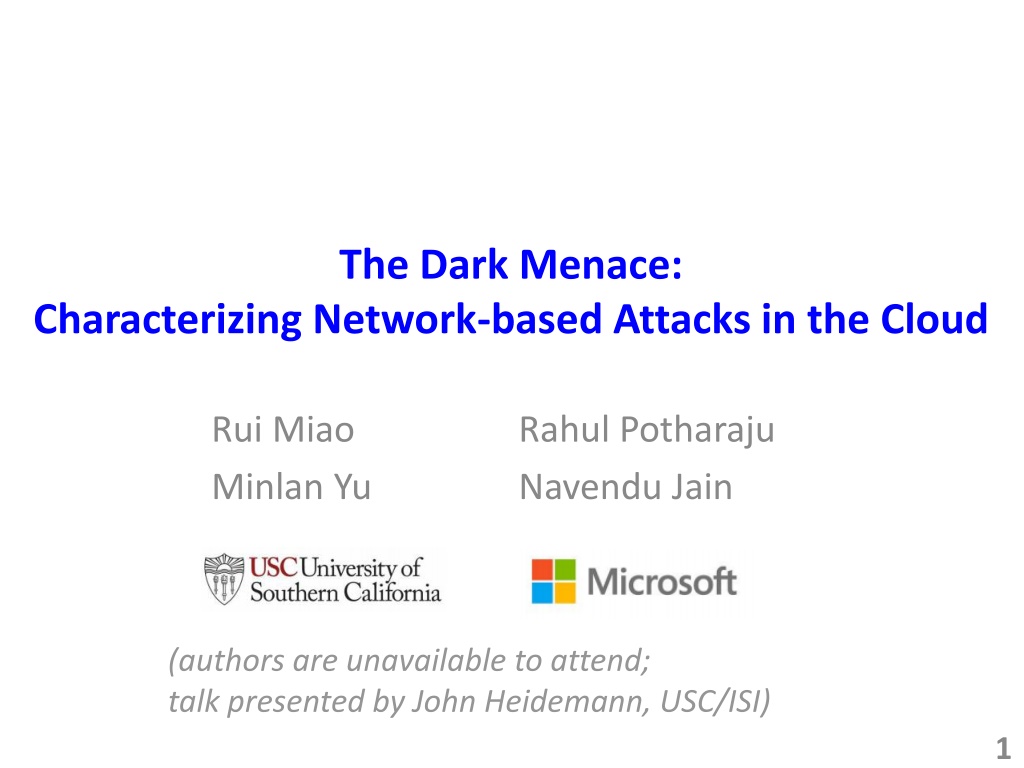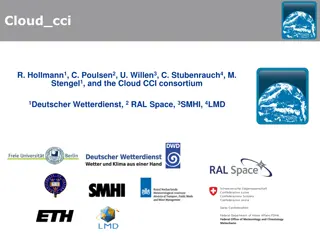Understanding Network-based Attacks in the Cloud: The Dark Menace
The presentation delves into the escalating threat landscape within cloud computing, highlighting the absence of comprehensive research. Key questions relate to the volume, nature, and actors behind cloud attacks, urging advancements in detection and compliance. The pioneering study characterizes diverse attacks, spanning DDoS assaults and SQL injections, aiming to guide cloud operators towards robust security measures.
Download Presentation

Please find below an Image/Link to download the presentation.
The content on the website is provided AS IS for your information and personal use only. It may not be sold, licensed, or shared on other websites without obtaining consent from the author. Download presentation by click this link. If you encounter any issues during the download, it is possible that the publisher has removed the file from their server.
E N D
Presentation Transcript
The Dark Menace: Characterizing Network-based Attacks in the Cloud Rui Miao Minlan Yu Rahul Potharaju Navendu Jain (authors are unavailable to attend; talk presented by John Heidemann, USC/ISI) 1
Cloud, Big and Cloud Attacks, Bad The market for cloud computing is growing Reached $40 billion in 2014; 23%-27% growth YoY 2
Cloud, Big and Cloud Attacks, Bad The market for cloud computing is growing Reached $40 billion in 2014; 23%-27% growth YoY Cloud becoming an attractive target for attacks inbound : from Internet into cloud In 2013, an attack caused 50+ services to go offline outbound: from cloud to Internet In 2011, 100+ million customer accounts compromised 3
Yet, There are no Systematic Studies Q1: How many attacks in and out? What attack types are prevalent? Q2: What do attacks look like? What is the peak rate? How long do they last? Q3: Who attacks and is attacked? What are the sources and targets? Do they spoof IPs? 4
Yet, There are no Systematic Studies Q1: How many attacks in and out? What attack types are prevalent? Q2: What do attacks look like? What is the peak rate? How long do they last? Q3: Who attacks and is attacked? What are the sources and targets? Do they spoof IPs? Implications: Guide cloud operators and researchers to 1. Analyze current DDoS mitigation approaches 2. Design new detection and mitigation solutions 3. Ensure compliance (ex: U.S. FISMA requirements) 5
Contribution: Characterize Attacks in the Cloud First study of cloud attacks: inbound and outbound Major cloud provider: 10,000+ services, 10+ data centers Collect three-month NetFlow data at edge routers Classification of cloud attacks: 9 types Network-level: a variety of DDoS attacks, port scan Application-level: SQL injection and spam Guidelines for detection and mitigation 6
Contribution: Characterize Attacks in the Cloud First study of cloud attacks: inbound and outbound Major cloud provider: 10,000+ services, 10+ data centers Collected three-month NetFlow data at edge routers Classification of cloud attacks: 9 types From DDoS to application-level SQL injection and spam Analyzed attack scale, complexity and distribution Guidelines for detection and mitigation Handle attack diversity and intensity (across VIPs, time) Enable application-defined security policies 7
Cloud Operation Traffic Cloud traffic enters Data Center Edge routers Is Routed and filtered Security appliance Datacenter networks Meets services each runs on a VIP Virtual IP Address VIP2 VIP1 NetFlix One Drive VM VM VM VM 8
Measuring Cloud Attacks Traffic Data Center Major cloud provider 10k+ services, 10+ data centers Capture NetFlow at edge routers 200 TB over three months Upstream of DDoS appliance Sampled at 1 in 4096 Cannot capture all the attacks Good for studying attack characteristics Aggregated in 1-minute window by VIPs Edge routers Netflow Security appliance Datacenter networks VIP2 VIP1 NetFlix One Drive VM VM VM VM VIP : Virtual IP for a service 9
Attack Categories and Detection TCP SYN flood UDP flood ICMP flood DNS reflection DNS responses by spoofed requests Spam Launch email spam to SMTP servers Brute-force Scan passwords or admin control SQL injection Send queries to exploit vulnerabilities Port scan Scan for open ports Malicious web (TDS) Send many packets to a server Communicate with malicious webs 10
Attack Categories and Detection TCP SYN flood UDP flood ICMP flood DNS reflection DNS responses by spoofed requests Spam Launch email spam to SMTP servers Brute-force Scan passwords or admin control SQL injection Send queries to exploit vulnerabilities Port scan Scan for open ports Malicious web (TDS) volume-based: packets/second with sequential change-point detection Send many packets to a server Communicate with malicious webs 11
Attack Categories and Detection TCP SYN flood UDP flood ICMP flood DNS reflection DNS responses by spoofed requests Spam Launch email spam to SMTP servers Brute-force Scan passwords or admin control SQL injection Send queries to exploit vulnerabilities Port scan Scan for open ports Malicious web (TDS) volume-based: packets/second with sequential change-point detection Send many packets to a server spread: abnormal fan-in or fan-out (# conns or hosts) Communicate with malicious webs 12
Attack Categories and Detection TCP SYN flood UDP flood ICMP flood DNS reflection DNS responses by spoofed requests Spam Launch email spam to SMTP servers Brute-force Scan passwords or admin control SQL injection Send queries to exploit vulnerabilities Port scan Scan for open ports Malicious web (TDS) volume-based: packets/second with sequential change-point detection Send many packets to a server spread: abnormal fan-in or fan-out (# conns or hosts) signatures: (TCP) Communicate with malicious webs 13
Attack Categories and Detection TCP SYN flood UDP flood ICMP flood DNS reflection DNS responses by spoofed requests Spam Launch email spam to SMTP servers Brute-force Scan passwords or admin control SQL injection Send queries to exploit vulnerabilities Port scan Scan for open ports Malicious web (TDS) volume-based: packets/second with sequential change-point detection Send many packets to a server spread: abnormal fan-in or fan-out (# conns or hosts) signatures: (TCP) communications with known malicious hosts Communicate with malicious webs 14
Characterizing Cloud Attacks Q1: How many attacks in and out? Q2: What do attacks look like? Q3: Who attacks and is attacked? 15
Attack Distribution 35% Inbound vs. 65% outbound normalized by total number of attacks More outbound floods than inbound: Easier to abuse the cloud resources Inbound are dominated by flood, brute-force, and port scan Outbound are dominated by flood, brute-force, and SQL injection Implication: High diversity Need several detection methods 2x more outbound attacks Improve security of out traffic16
Validation: How Complete Are We? Inbound method: compare us to security appliance DDoS alerts we see most inbound attacks (79% of appliance-reports) miss some attacks due to NetFlow sampling (1:4096) Alerts may have some false positives (e.g., flash crowds) Outbound method: compare us to external complaints (incident reports) we see most outbound attacks (84% of incident reports) we miss application-level attacks (e.g., phishing, malware) 17
Characterizing Cloud Attacks Q1: How many attacks in and out? 9 diverse attack types: From DDoS to SQL injection, spam Inbound vs. outbound: 2x more outbound attacks Q2: What do attacks look like? Q3: Who attacks and is attacked? 18
Characterizing Cloud Attacks Q1: How many attacks in and out? 9 diverse attack types: From DDoS to SQL injection, spam Inbound vs. outbound: 2x more outbound attacks Q2: What do attacks look like? Q3: Who attacks and is attacked? 19
Attack throughput Attacks consume lots of cloud resources median aggregate attack traffic is 1% of mean cloud traffic attackers are disproportionally heavy (1% tfc but ~0.1% VIPs) High variation in throughput across time and VIPs Inbound floods have 13-238 times higher peak than outbound Inbound brute-force: Peak vs. median = 361 times Implication: Attack defenses need to dynamically adapt resources (over time and VIPs) to be cost-effective 20
Attack duration Attacks often have short duration ( < 10 min) Hard to detect Quickly move to a different target A few attacks can last hours or even days DNS reflection has long duration Hard to detect: from many DNS resolvers having a low query rate Often with short duration Implication: Need fast (order of 10s-100s of seconds) and accurate detection to defend against most attacks 21
Attack frequency per VIP Only a small fraction of VIPs involved Inbound: 8 out of 10,000 VIPs per day Outbound: 11 out of 10,000 VIPs per day Occasional attacks vs. frequent attacks A few VIPs experience 30-150 attacks in a day (usually SYN floods) Mostly one attack in a day *VIP : Virtual IP Implication: Need to focus on the VIPs at the tail for attack detection and mitigation 22
Attacks on the same VIP Multi-vector attacks: exploit the vulnerabilities 6.1% of inbound attacks and 0.83% of outbound attacks Compromised VIPs for outbound attacks Inbound brute-force attack from 85 sources over one week Outbound UDP flood against ~500 Internet sites Implication: Need joint analysis of inbound and outbound traffic to identify causality in attacks; find compromised VMs23
Attacks on multiple VIPs Most attacks have only a few targets 1 VIP in the median, <10 VIPs in the 99th percentile A few cases with 20-60 VIPs simultaneously Brute-force on 60+ VIPs: Two sources scan 8 IP subnets (500 VIPs) over 5 data centers Implication: Need to correlate traffic across VIPs to coordinate attack detection and mitigation 24
Characterizing Cloud Attacks Q1: How many attacks in and out? 9 diverse attack types: From DDoS to SQL injection, spam Inbound vs. outbound: 2x more outbound attacks Q2: What do attacks look like? Peak rate: 100pps-9Mpps; out 13x-238x higher than in Duration: Most attacks have short duration (<10 mins) Frequency: Most VIPs see 1 attack/day; a long tail exists Q3: Who attacks and is attacked? 25
Characterizing Cloud Attacks Q1: How many attacks in and out? 9 diverse attack types: From DDoS to SQL injection, spam Inbound vs. outbound: 2x more outbound attacks Q2: What do attacks look like? Peak rate: 100pps-9Mpps; out 13x-238x higher than in Duration: Most attacks have short duration (<10 mins) Frequency: Most VIPs see 1 attack/day; a long tail exists Q3: Who attacks and is attacked? 26
Origins of inbound attacks Big cloud, Small ISPs and Customer Net dominate Less security expertise and weak defenses; relatively easy to be compromised by attackers Percentage of attacks Mostly high-volume UDP floods, SQL injection, TDS attacks due to large availability of resources Implications: (1) Better cloud security can help everyone; (2) Need to help those with less security expertise 27
Targets of outbound attacks Attacks target many ASes Top 10 ASes are targets of 8.9% of the attacks Specific attacks target hosts in one AS, usually (80%) Mostly SQL injection and TDS attacks Mostly brute-force and spam Percentage of attacks Implication: Important to coordinate measures across the cloud and these networks to protect against these attacks 28
More in the paper Are source IPs spoofed? What is the inter-arrival time of attacks? What services are targeted by attacks? How prevalent are attacks from mobile networks? What is the geo-distribution of attacks? 29
Conclusion Cloud attacks are prevalent, both in and out Key findings: attacks are diverse: type, scale and distribution outbound attacks dominate: many compromised cloud VMs existing DDoS defenses are limited: many short attacks Implications: using correlation can improve detection need programmable, scale-out, and flexible solutions to detect diverse attacks questions? {rmiao, minlanyu}@usc.edu, {rapoth,navendu}@microsoft.com 30
Identify the attack incidents Cannot detect an attack over its entire duration Due to low sampling rate in NetFlow Separate attack incidents using inactive heuristic Aggregate NetFlow by VIP in 1-minute window Measure inactive time between two attack minutes Pick ``knee point using linear regression: No statistically significant difference in the #incidents 32























